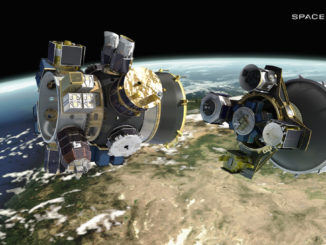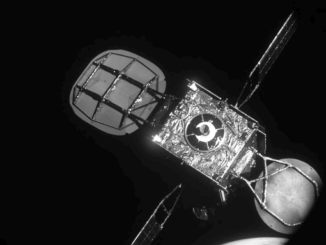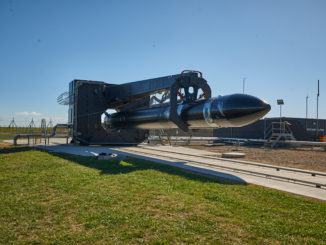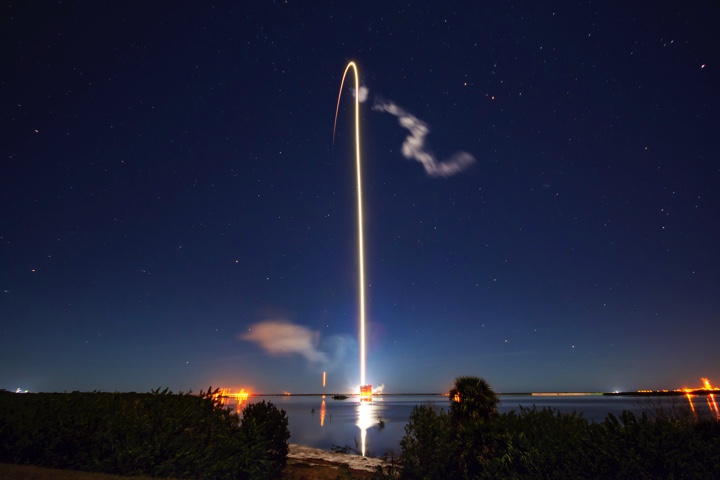
Sixty more satellites for SpaceX’s Starlink global Internet network streaked into orbit Monday night from Cape Canaveral, including one spacecraft to test an experimental dark coating to address scientists’ concerns that the thousands of the quarter-ton, flat-panel satellites will impede astronomical observations.
The launch of 60 more spacecraft for the Starlink project, which SpaceX sees as a core business area in the coming years, makes the company the operator of the largest fleet of commercial satellites, surpassing the previous mark set by Planet, an operator of Earth-imaging nanosatellites.
SpaceX wants to begin limited Internet service through the Starlink network later this year, then expand to global service to beam Internet signals to consumers in far-flung locales outside the reach of terrestrial wired broadband connections. Users on airplanes, ships and the U.S. military could also be Starlink customers.
Blazing a similar trail to two previous Starlink satellite launches last year, a SpaceX Falcon 9 rocket lifted off from pad 40 at Cape Canaveral at 9:19:21 p.m. EST Monday (0219:21 GMT Tuesday) and turned on a northeasterly heading over the Atlantic Ocean.
Nine kerosene-fueled Merlin 1D engines on the base of the first stage powered the rocket off the launch pad with 1.7 million pounds of thrust.
After two-and-a-half minutes, the nine main engines shut down and the first stage separated to begin descent maneuvers toward a landing on SpaceX’s drone ship “Of Course I Still Love You” in the Atlantic Ocean.
The first stage — flying for the fourth time on Monday night’s mission — nailed its landing on the drone ship, marking the 48th time SpaceX has successfully landed a Falcon booster since the company’s first rocket recovery in 2015. An attempt to catch one half of the Falcon 9’s clamshell-like payload fairing in a net fastened to an ocean-going vessel was unsuccessful, SpaceX said.
The Falcon 9’s second stage ignited its Merlin engine two times to place the 60 Starlink satellites into an orbit with a target altitude of 180 miles (290 kilometers) and an inclination of 53 degrees to the equator. SpaceX confirmed the Falcon 9 injected the payloads close to the planned orbit.
Retention rods holding the 60 flat-panel Starlink spacecraft to the Falcon 9 rocket released at 10:20 p.m. EST (0320 GMT) to allow separation of the satellites.
Retention rods holding the 60 Starlink satellites to the Falcon 9’s second stage have been released. The 60 spacecraft are floating away from the Falcon 9 rocket as it soars at an altitude of nearly 200 miles south of Australia. https://t.co/KNZ3rpnyfs pic.twitter.com/Hu8OIrtqqd
— Spaceflight Now (@SpaceflightNow) January 7, 2020
An on-board camera view showed the 60 satellites deploy from the Falcon 9’s second stage. The Starlink relay stations were expected to begin dispersing in the coming days, while SpaceX control teams perform tests and activate the satellites’ krypton-fed ion thrusters to begin maneuvering toward their planned operating altitude of 341 miles (550 kilometers).
The launch Monday kicked off a brisk pace of launches by SpaceX planned for 2020.
Gwynne Shotwell, SpaceX’s president and chief operating officer, said last month the company could perform as many as 35 to 38 launches this year from three launch pads in Florida and California. That figure does not include potential test flights of SpaceX’s next-generation Starship vehicle.
The bulk of SpaceX’s missions in 2020 will add satellites to the company’s Starlink constellation of broadband satellites.
SpaceX plans to operate the initial block of 1,584 Starlink satellites in orbits 341 miles above Earth. The company has regulatory approval from the Federal Communications Commission to eventually field a fleet of up to 12,000 small Starlink broadband stations, and has hinted in additional regulatory filings that it could seek to operate up to 42,000 Starlink spacecraft.
In response to concerns from astronomers, Shotwell said one of the 60 satellites set for launch Monday will test a new less-reflective coating designed to reduce the brightness of the spacecraft. The first 120 satellites were brighter than expected, raising worries from scientists that thousands of Starlink craft could interfere with astronomical observations.
The satellites are especially bright soon after launch, when they are bunched together and flying at lower altitudes.
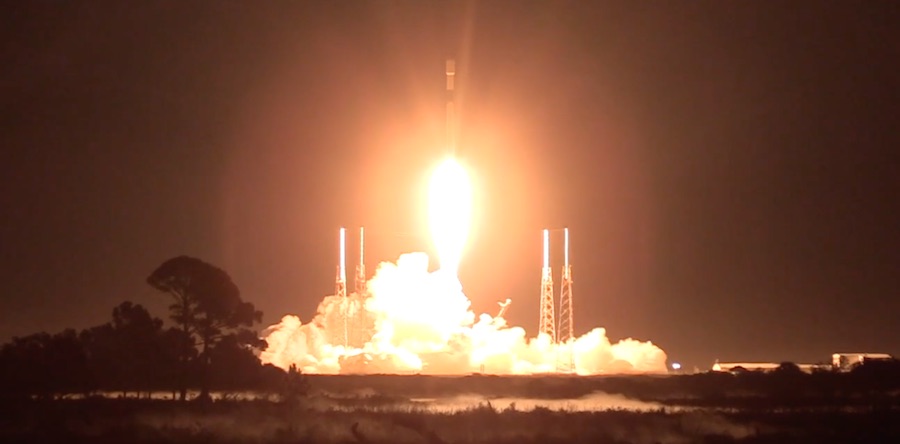
“During orbit raise, the satellites are closely clustered together and their solar arrays are positioned in a special low-drag configuration, making the satellites appear visible from the ground just after deployment,” said Lauren Lyons, a SpaceX engineer who co-hosted the company’s webcast of Monday night’s launch. “However, once the satellites reach their operational altitude and begin on-station service, their orientation changes and the satellites become significantly less visible.
“While it’s really cool to catch a glimpse of those satellites from the ground, they can sometimes be a distraction for astronomers,” Lyons said. “So on this flight, Starlink is testing an experimental darkening treatment on one satellite in order to further reduce the light reflection off the satellites.”
SpaceX is seeking to strike a balance between astronomers’ concerns and the company’s ambitions for the Starlink network. Skywatchers will gauge the effectiveness of the new experimental coating to determine if it reduces the reflectivity of the satellite, and SpaceX wants to ensure the treatment does not impact the performance of the spacecraft.
“We also make satellite tracking data available to astronomers so they can better coordinate their observations with our satellites,” Lyons said. “These measures, along with our work with leading astronomy groups, will enable SpaceX to bring Internet access to underserved and unserved populations around the world without materially impacting the use of the night sky.”
SpaceX says it hopes to begin regional broadband service to Canada and the northern United States with the partially-complete Starlink constellation by the middle of this year, once it has launched 12 Starlink missions. Starlink service for Internet consumers worldwide will come after 24 launches, according to Shotwell.
“Twelve launches gets us connectivity with no gaps down to a latitude of roughly 25 degrees … And then 24 missions gets us global coverage with no data gaps,” Shotwell said last month. “So what’s preventing us from providing service? Getting the right number of satellites up in orbit. We will start offering service (mid-2020) because we have those 12 launches.”
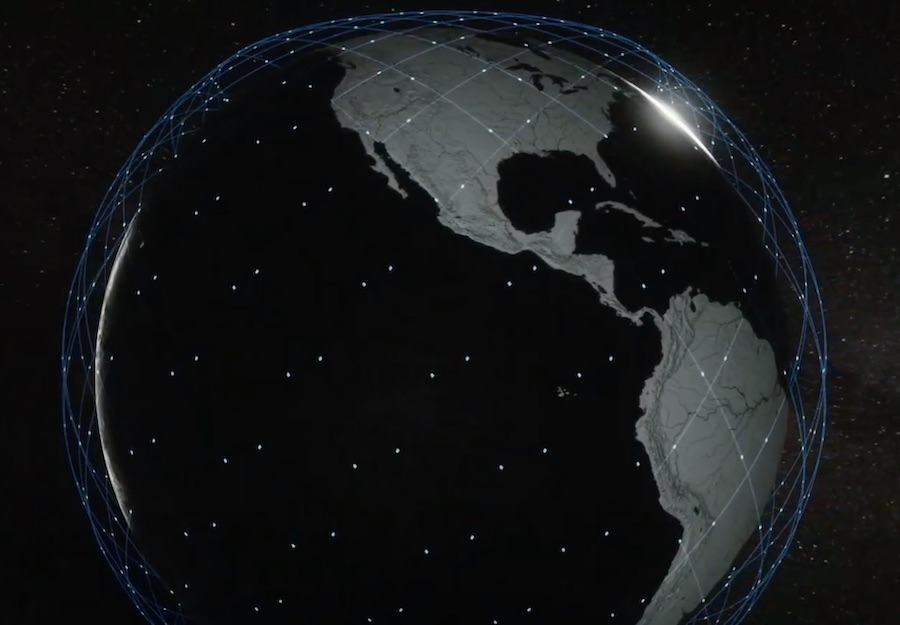
SpaceX has not announced pricing for the Starlink service.
“All I know is you will be far happier with the value of the Starlink service than you are with your current service,” Shotwell said in December. “You will, for sure, get way more bandwidth for the same price, or way more bandwidth for less … You’ll be far happier with this. The value will be far greater (than with current Internet service providers).”
She said SpaceX is building about seven Starlink satellites per day at a factory in Redmond, Washington. Low-volume production of SpaceX’s ground user terminals is also underway in California, Shotwell said.
SpaceX is still working out its strategy for commencing Starlink commercial services.
“Between now and June … we’re going to have to figure that out,” Shotwell said last month. “We will do presales like Tesla has done. The initial experience will be bumpy. We’ll have early customers be part of that journey with us. We’re not going to fib and say it’s going to be the best thing ever. When you get service, it’s going to be great. But it will be bumpy for a while.
The U.S. military has a contract with SpaceX to demonstrate the Starlink network’s ability to deliver data to the cockpit of airplanes, the first of what SpaceX hopes will be a lucrative business selling bandwidth to the Defense Department.
“I think we probably will mature as a provider, and it should not be bumpy, really in ’21. By ’21, I think we probably will have figured out most of the problems.”
SpaceX is gearing up for at least one more Starlink launch from Cape Canaveral using a Falcon 9 rocket later this month.
But first, the company’s Florida team will perform an in-flight test of the abort system the Crew Dragon commercial crew capsule on the ship’s final demonstration launch before NASA clears SpaceX to launch astronauts to the International Space Station.
The Crew Dragon in-flight abort test will take off from pad 39A at NASA’s Kennedy Space Center aboard a modified Falcon 9 rocket. Once it reaches the stratosphere, the crew capsule — flying without astronauts this time — will trigger its launch escape engines to propel itself away from the Falcon 9, verifying the ship’s ability to carry crews away from a failing rocket.
Email the author.
Follow Stephen Clark on Twitter: @StephenClark1.

